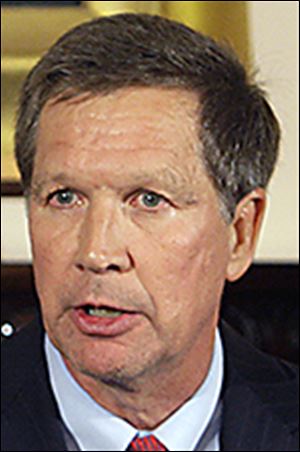
LUCAS COUNTY AGENCY
Mental health chief says state draining funds
Law gives ‘illusion of more money’
6/19/2014
Sylak
Editor's note: This version corrects the name of State Rep. Robert Sprague (R., Findlay).

Sylak
The local director of mental health and drug addiction services is charging that Gov. John Kasich has taken back money previously allocated to county agencies and is instead redirecting the money to the state mental health board for drug-addiction initiatives across the state.
As a result, the state board will have more control over which programs receive approval and urban areas like Lucas County will likely receive less funding as money is funneled to rural communities, said Scott Sylak, executive director of the Mental Health and Recovery Services Board of Lucas County.
Governor Kasich signed into law Monday a midterm budget bill that addresses several areas such as tax cuts and windmill regulations. The new law also made adjustments to the two-year budget bill passed by the state legislature.
Many provisions received praise from social service advocates.
According to the Ohio Department of Mental Health and Addiction Services, the bill provides $47.5 million more for addiction programs, including housing assistance and residential treatment.
Mr. Sylak however, said the governor is merely robbing Peter to pay Paul. “It is the illusion of more money,” he said.
He said the midterm budget changed the funding formula established just last year and Lucas County will no longer receive about $2.6 million that was originally allocated. “It’s a new paradigm,” he said.
Lucas County will receive some additional money but the unanswered question is how much, Mr. Sylak said. The Lucas County mental health board also receives money from local taxpayers via a 1-mill, 10-year levy voters approved for the board in 2012.
State Rep. Robert Sprague (R., Findlay) was one of the key advocates of directing money to the state agency instead of giving it directly to the local boards to provide addiction programs. The governor’s midterm budget included many provisions originally proposed by Mr. Sprague including requiring counties to provide coordinated resources for detoxification, medication-assisted treatment, individual and group therapy, residential treatment, and peer mentoring.

Kasich
“We are saying everybody has to step up. We have to upgrade the treatment system because what we are doing right now is not cutting it. Overdose rates are continuing to climb. We are trying to direct money toward gaps in the system that local boards will help identify. On the other hand, if we let local boards decide where to spend the money, they are going to keep doing what they are doing now and that doesn’t cut it,” Mr. Sprague said.
Mr. Sprague added that when state officials made the original budget allocations to addiction and mental health boards Medicaid expansion had not been approved in Ohio. In October, Medicaid expansion freed up $70 million for these local boards, he said.
Tom Clemons, executive director of the Wood County Alcohol, Drug Addiction and Mental Health Services Board said that for many years the state has worked under the assumption that local communities know best what they need, and he finds it ironic that a Republican governor and legislature are pushing a top-down model that adds another level of bureaucracy to the process.
Under the new process, the state will take a more regional approach to funding services. In Northwest Ohio, for example, there are 12 mental health and addiction services boards, including one in Lucas County, that will now have to meet, look for opportunities to work together, and then decide which programs should receive funding.
“We are the largest entity that basically represents 40 percent of the population but we have a singular vote,” Mr. Sylak said.
The state agency will have the final word over which local programs receive the state dollars.
“The question is, is this a better way forward? Top down has some advantages and disadvantages. I can see how it can create some efficiencies,” Mr. Clemons said. He added that Wood County has tested a school program that addresses drug prevention but now the state is pushing a new, different prevention program called “Start Talking.”
“We have 10 years of data that shows our prevention programs are working. Marijuana use in Wood County has gone down over the last two years. I know they want to do this ‘Start Talking.’ I don’t know much about it and my sense is they haven’t gathered the scientific evidence behind it,” he said.
“You can call it a layer of bureaucracy but what I call it is actually having the system work correctly. Right now, it doesn't work, and we can do better,” Mr. Sprague said.
Contact Marlene Harris-Taylor at mtaylor@theblade.com or 419-724-6091.